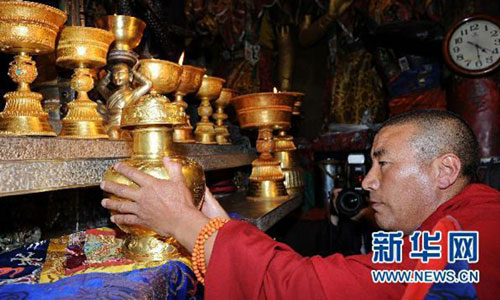Li Decheng
On December 27, US President Donald Trump signed the so-called “Tibetan Policy and Support Act of 2020” – a bill grossly interfering in China’s internal affairs. The bill claimed that the person who reincarnates has “sole legitimate authority” over “where and how he or she takes rebirth and how that reincarnation is to be recognized and if there is a need for a 15th Dalai Lama.” It also smeared the Chinese government’s handling of the reincarnation process, which is in accordance with the law, as a violation of so-called “religious freedom.”
It is well-known that the reincarnation of the living Buddhas is by no means a purely religious affair, let alone an “authority” of those who reincarnate claimed by those with ulterior motives.
Golden urn lot-drawing The reincarnation of the living Buddhas initially appeared to settle the problem of the succession of leaders of Tibetan Buddhist sects. In old Tibet, which adopted a “theocratic” system, the Tibetan people who believed in Buddhism obeyed religious leaders. Due to the prominent and leading role of the influential living Buddhas, various political and religious forces in Tibetan society vied for dominant power and control over the reincarnation of the living Buddhas. This has led the reincarnation system to gradually lose its original meaning and cause great harm to the Dharma as well as endangering social stability and national security. Therefore, the then central government adopted the system of lot-drawing from a golden urn in 1793 to improve the reincarnation order of the living Buddhas. The system not only helped to prevent malpractices in the reincarnation of living Buddhas, but also showed respect for the principles and traditions of the reincarnation of living Buddhas as well as the sentiment of believers. Moreover, it shows the authority of the central government over the reincarnation process.
To eliminate corrupt practices in the reincarnation of living Buddhas, Emperor Qianlong of the Qing Dynasty (1636-1912) responded to the request of the Eighth Dalai Lama and ordered officials in Tibet to discuss the regulations after the victory of expelling the Gurkha invasion in 1792. In the following year, the Qing government issued an imperial decree – the 29-Article Ordinance for the More Efficient Governing of Tibet.
Article one of the Ordinance clearly stipulates that “in order to ensure the Yellow Sect continues to flourish, the Grand Emperor bestows it with a golden urn and ivory slips for use in confirming the boy possessing the reincarnated soul of a deceased living Buddha. For this purpose, four major Buddhist Guardians will be summoned; the names of candidates, as well as their birth years, will be written on the ivory slips in three languages – Manchu, Han Chinese and Tibetan; the ivory slips will be placed into the golden urn and the prominent living Buddhas will pray for seven days before various Hotogtu Living Buddhas and the resident minister of the central government officially confirm the boy with the reincarnated soul by drawing a lot from the golden urn in front of the statue of Sakyamuni in the Jokhang Monastery.” As for the confirmation of the boys with the souls of the Dalai and Panchen, “the same practices should be conducted and they were designed to allow the flourishing of the Yellow Sect and to avoid cheating from the guardians.”
Approval from the central government The establishment of the reincarnation of the living Buddhas system is inseparable from the support of the central government, thus forming the ultimate authority of the central government in the process. It has also become a historical convention for the central government to approve the succession of the influential living Buddhas.
In 1288, Rangjung Dorje was enthroned in Tsurphu Monastery, forming the reincarnation system called black hat lineage of Karma Kagyu sect, since Emperor Xianzong of Yuan Dynasty (1271-1368) previously bestowed a black hat with golden brim to his predecessor Karma Pakshi. This black hat has become the symbol of the Gyalwang Karmapa succession system of the Karma Kagyu Sect and it also showed the authority of the central government in the system of the living Buddhas reincarnation.
In 1332, Rangjung Dorje was summoned to Dadu (now Beijing) to pay respects to the emperor. Emperor Shundi conferred him titles and awarded him decrees and seals.
Through the conferment, the legal identity and status of the reincarnation of the living Buddha of Rangjung Dorje were confirmed by the central government of the Yuan Dynasty, and the reincarnation was endowed with legal meaning and legitimacy. This further promoted the development of the living Buddhas reincarnation system.
In 1653, the Fifth Dalai Lama journeyed to Beijing to pay homage to Emperor Shunzhi. The Qing emperor granted him the honorific title of “the Dalai Lama, Overseer of the Buddhist Faith on Earth Under the Great Benevolent Self-subsisting Buddha of the Western Paradise.” Since then, the system of conferring the reincarnation of successive Dalai Lamas by the central government has become a convention.
The current Dalai Lama was enthroned in the Potala Palace on February 22, 1940, during a ceremony presided over by Wu Zhongxin, minister of the Commission for Mongolian and Tibetan Affairs of the nationalist government of the Republic of China (1912-49).
[The author is a research fellow of the China Tibetology Research Center.]










